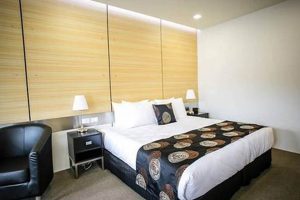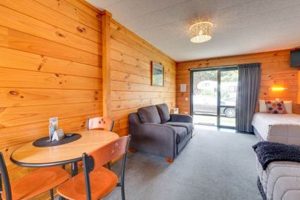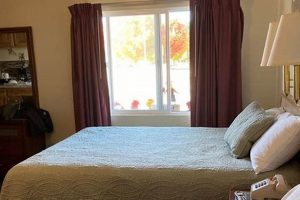Extended-stay lodging, offering the amenities of a motel combined with the practicality of a residential space, provides a unique housing solution. Imagine a space with kitchen facilities, a designated sleeping area, and the convenience of daily housekeeping, all within a motel setting. This type of accommodation caters to individuals or families seeking temporary or long-term housing, providing a more cost-effective and flexible alternative to traditional apartments or rental properties.
This housing model fills a critical gap in the market, offering affordability and convenience to those in transition, such as relocating professionals, traveling workers, or individuals experiencing unforeseen housing disruptions. Historically, such accommodations emerged to serve the needs of a mobile workforce and evolving travel patterns. The flexibility they offer remains highly relevant today, providing a vital resource for individuals seeking a blend of comfort and practicality. This approach offers a sense of stability and community not always found in traditional short-term lodgings.
The following sections delve further into the advantages and disadvantages of this housing solution, exploring the financial aspects, lifestyle considerations, and the evolving landscape of the extended-stay industry. An in-depth examination of available resources and support systems for residents will also be provided.
Tips for Selecting Extended-Stay Accommodations
Choosing suitable extended-stay accommodations requires careful consideration of various factors. The following tips offer guidance for navigating this process effectively.
Tip 1: Research Location Thoroughly: Proximity to essential amenities like grocery stores, pharmacies, and transportation hubs is crucial. Consider the surrounding neighborhood’s safety and accessibility.
Tip 2: Evaluate Amenities and Services: Assess the availability of in-room kitchens, laundry facilities, internet access, and housekeeping services. Determine which amenities are essential for comfortable long-term living.
Tip 3: Compare Costs and Lease Terms: Request detailed pricing information, including any additional fees or deposits. Carefully review lease terms regarding length of stay, cancellation policies, and pet allowances.
Tip 4: Consider Safety and Security: Inquire about security measures, such as surveillance systems, on-site management, and well-lit common areas. Prioritize accommodations that prioritize guest safety.
Tip 5: Read Reviews and Testimonials: Gain valuable insights from previous residents by researching online reviews and testimonials. This can provide a realistic perspective on the quality and experience of the accommodations.
Tip 6: Inspect the Property: Whenever possible, conduct a thorough inspection of the property before committing to a long-term stay. Verify the condition of the room, appliances, and common areas.
Tip 7: Inquire about Community and Support: Extended stays can benefit from a sense of community. Investigate opportunities for resident interaction or available support services provided by the management.
By carefully considering these factors, individuals can select extended-stay accommodations that best meet their needs and provide a comfortable and convenient living experience.
The insights provided in this guide equip individuals to make informed decisions regarding their extended-stay housing needs. The following section provides a concluding overview of the key takeaways.
1. Extended Stay
Extended stay forms the cornerstone of the “motel home” concept. It represents a shift from transient lodging to a more permanent, yet flexible, housing solution. This duration allows individuals and families to establish a sense of routine and stability, even while residing in a motel environment. The extended stay component distinguishes a “motel home” from typical short-term motel stays, catering to those requiring accommodation for weeks, months, or even longer. For example, a consultant on a protracted project, a family relocating while awaiting the completion of a new home purchase, or individuals displaced by unforeseen circumstances could benefit from extended stay options.
The significance of “extended stay” within the “motel home” framework lies in its ability to bridge the gap between temporary housing and traditional rentals. It offers the convenience and affordability of a motel coupled with the practicality of a longer-term lease. This model provides a viable alternative to costly apartment leases, particularly for those with uncertain timelines or who prioritize flexibility. Consider a traveling medical professional on a multi-month assignment. An extended stay motel provides a furnished, equipped space without the commitment of a year-long lease or the hassle of furnishing a short-term rental. This allows them to focus on their work while maintaining a sense of home.
Understanding the role of extended stay within the “motel home” context clarifies its benefits and applications. This model addresses a specific need within the housing market, offering a unique blend of flexibility and affordability. While challenges such as limited space and potential lack of certain amenities exist, the extended stay model provides a vital housing solution for a growing segment of the population. Further exploration into the specific needs and challenges of extended stay residents can inform the development of improved services and resources within this evolving sector.
2. Residential Feel
The “residential feel” of a motel home distinguishes it from traditional, transient motel accommodations. This sense of home, despite the temporary nature of the arrangement, emerges from several key factors. Providing kitchen facilities allows residents to prepare meals, fostering a sense of normalcy and routine. Designated sleeping and living areas, separate from the kitchenette, create a more home-like environment than a standard motel room. The availability of on-site laundry facilities adds to the convenience and practicality, further contributing to the residential atmosphere. For instance, a family relocating due to a job change can maintain some semblance of domestic life by cooking familiar meals and having distinct spaces for rest and relaxation, easing the stress of the transition. Similarly, extended-stay business travelers appreciate the ability to maintain a healthier diet and a more comfortable routine with in-room kitchen facilities. This allows them to feel more at home while away from their permanent residence.
The creation of a residential feel within a motel setting significantly impacts the overall experience of extended-stay residents. This design approach caters to the fundamental human need for comfort and stability, even in temporary living situations. The psychological benefits are substantial, reducing stress and promoting a sense of well-being. For example, having a dedicated workspace within the room allows for greater productivity and focus for those working remotely. The ability to control one’s meal preparation contributes to healthier eating habits and reduces reliance on restaurant dining. Furthermore, the sense of community fostered by shared amenities, such as laundry facilities or common areas, can mitigate feelings of isolation often associated with temporary housing. This emphasis on a residential atmosphere elevates the motel home concept beyond basic accommodation to a more holistic and supportive living experience.
In summary, incorporating a residential feel represents a crucial aspect of the motel home model. This approach acknowledges the psychological and practical needs of extended-stay residents, transforming temporary lodging into a more comfortable and functional living space. The benefits extend beyond mere convenience, impacting residents’ overall well-being and sense of stability. While challenges related to space constraints and the balance between privacy and community remain, the emphasis on a residential feel significantly enhances the value proposition of motel home accommodations within the broader housing landscape. Addressing these challenges through innovative design and management strategies will further solidify the role of motel homes as a viable and appealing long-term housing solution.
3. Motel Amenities
The availability of motel amenities significantly shapes the “motel home” experience, influencing its practicality and appeal as a long-term housing solution. These amenities bridge the gap between traditional motel stays and apartment living, offering residents a blend of convenience and support. Daily housekeeping services alleviate the burden of cleaning and maintenance, allowing residents to focus on other priorities. On-site laundry facilities provide essential practicality, eliminating the need for external laundromats. The inclusion of Wi-Fi and cable television offers entertainment and connectivity, essential for both leisure and remote work. For example, a traveling professional benefits from reliable internet access to maintain productivity, while a family appreciates the convenience of on-site laundry facilities, reducing household chores. The availability of these services enhances the overall comfort and functionality of the motel home, making it a viable alternative to traditional rental arrangements.
The strategic inclusion of motel amenities within the “motel home” model contributes directly to its viability as a long-term housing option. These amenities cater to the practical needs of residents, fostering a sense of ease and convenience. Consider a single parent balancing work and childcare. Having access to daily housekeeping services frees up valuable time and reduces stress. Similarly, on-site fitness centers offer opportunities for physical activity without requiring additional gym memberships. Furthermore, the presence of a swimming pool provides a recreational outlet, particularly beneficial for families with children. By integrating these amenities, motel homes address the multifaceted needs of residents, creating a more supportive and well-rounded living experience. This approach distinguishes motel homes from basic extended-stay options, enhancing their appeal to a broader demographic seeking convenient and functional long-term accommodations.
In conclusion, motel amenities play a pivotal role in defining the “motel home” concept, transforming it from simply a place to stay into a functional and convenient living space. These services enhance the overall resident experience, contributing to a sense of comfort and practicality. Addressing the challenge of balancing cost-effectiveness with the provision of comprehensive amenities remains crucial for the continued success of this housing model. Further exploration into resident needs and preferences can guide future development and refinement of amenity offerings within the evolving landscape of extended-stay accommodations.
4. Affordability
Affordability often represents a primary driver in the selection of a “motel home” as a housing solution. Lower upfront costs, compared to traditional rentals, eliminate the need for security deposits and first/last month’s rent, easing the financial burden on individuals and families. The absence of lease agreements provides flexibility, allowing residents to adjust their stay according to evolving circumstances. Weekly or monthly rates offer predictable budgeting, aligning with various income streams. For example, a contract worker with fluctuating income benefits from the pay-as-you-go structure of motel home living, avoiding the long-term financial commitment of a lease. Similarly, a family facing temporary displacement due to unforeseen circumstances finds the lower initial costs of a motel home crucial for managing unexpected expenses. This affordability expands housing accessibility for individuals and families across diverse economic situations.
The cost-effectiveness of “motel home” living extends beyond initial expenses. Inclusive utilities, such as water, electricity, and often internet access, simplify budgeting and eliminate unexpected bills. The availability of kitchen facilities enables residents to prepare meals, reducing reliance on costlier restaurant dining. On-site laundry facilities further minimize expenses, avoiding the need for external laundromats. Consider a student undertaking a short-term internship in a new city. The inclusive utilities and kitchen facilities within a motel home contribute significantly to managing a limited budget, maximizing available resources for educational and professional pursuits. This practicality enhances the appeal of motel homes as a financially sustainable housing solution, particularly for those seeking temporary or transitional accommodations.
In summary, affordability stands as a cornerstone of the “motel home” concept. The reduced financial barriers, predictable budgeting structures, and inclusion of essential utilities contribute to its viability as a practical and accessible housing option. Addressing the ongoing challenge of balancing affordability with quality and the provision of essential amenities remains crucial for the sustained success of this model. Further exploration of innovative approaches to cost management within the extended-stay sector can enhance housing affordability for a wider population, addressing a critical need within the broader housing landscape.
5. Flexibility
Flexibility represents a defining characteristic of the “motel home” model, distinguishing it from traditional lease-bound housing arrangements. This adaptability caters to the evolving needs of individuals and families seeking temporary or transitional accommodations. The following facets illuminate the various dimensions of flexibility within the context of “motel home” living.
- Variable Length of Stay
Motel homes accommodate varying durations of stay, from weekly to monthly or even longer-term arrangements. This adaptability contrasts with the fixed-term leases typical of apartment rentals. A consultant on a project with an uncertain timeline, for instance, benefits from the ability to extend or shorten their stay as needed. This flexibility reduces financial strain and provides peace of mind, allowing residents to adapt to changing circumstances without penalty.
- Simplified Move-In/Move-Out Processes
The streamlined nature of motel home check-in and check-out procedures simplifies transitions. Minimal paperwork and the absence of complex lease agreements expedite the process, making it ideal for individuals relocating quickly or facing unforeseen housing disruptions. For example, a family displaced by a natural disaster can secure immediate accommodation without navigating lengthy application processes or lease negotiations. This ease of access provides critical support during challenging transitions.
- Adaptable to Changing Needs
Motel homes offer adaptability to changing needs. Residents can often upgrade or downgrade room types as circumstances evolve. This allows for adjustments in space requirements or budget considerations, providing flexibility throughout the duration of the stay. A traveling nurse initially requiring a smaller room might later opt for a larger space to accommodate visiting family members. This adaptability ensures the accommodation continues to meet evolving needs without requiring a complete relocation.
- Location Variety and Availability
Motel homes offer a range of locations, from urban centers to suburban areas. This widespread availability allows individuals to select accommodations close to employment, family, or other essential resources. A student undertaking a summer internship can find a motel home near their workplace, simplifying commute logistics. This location flexibility enhances the practicality and convenience of motel home living, catering to diverse geographic needs.
In conclusion, flexibility serves as a cornerstone of the “motel home” concept, providing residents with adaptable housing solutions tailored to their unique circumstances. The variable length of stay, simplified move-in/move-out processes, adaptable room options, and diverse location availability distinguish motel homes from traditional rentals, offering a dynamic and responsive approach to temporary housing. This flexibility empowers residents to navigate transitions with greater ease and control, addressing the evolving needs of a mobile and increasingly transient population. Further exploration of flexible housing models can contribute to more resilient and adaptable housing solutions within the broader context of modern living.
Frequently Asked Questions about Motel Homes
This section addresses common inquiries regarding motel homes, providing clarity on key aspects of this housing solution.
Question 1: What distinguishes a motel home from a standard motel room?
Motel homes are designed for extended stays, offering amenities such as kitchenettes, larger living spaces, and often on-site laundry facilities. Standard motel rooms typically cater to short-term stays and lack these residential features.
Question 2: What lease terms are typically associated with motel homes?
Lease terms vary, but often involve weekly or monthly agreements rather than annual contracts. This flexibility allows for adaptable lengths of stay, catering to individual needs.
Question 3: Are utilities typically included in motel home rates?
Utilities such as water, electricity, and internet access are frequently included in the quoted rate, simplifying budgeting and expense management for residents.
Question 4: What are the typical costs associated with a motel home compared to a traditional apartment rental?
Motel homes typically involve lower upfront costs, eliminating the need for security deposits and first/last month’s rent often required for traditional apartment rentals. However, long-term costs may vary depending on location and amenities.
Question 5: What security measures are typically in place at motel homes?
Security measures vary by property but may include on-site management, surveillance systems, and exterior lighting. Inquiries regarding specific security protocols are recommended when considering a motel home.
Question 6: Are pets typically allowed in motel homes?
Pet policies vary by property. Some motel homes welcome pets, while others may have restrictions on size, breed, or associated fees. Confirming pet policies in advance is essential.
Understanding these key aspects of motel home living facilitates informed decision-making. Prospective residents are encouraged to contact specific properties directly to address individual needs and circumstances.
For further information regarding specific locations, amenities, and availability, please consult the resources listed in the following section.
Motel Home
This exploration of the “motel home” concept reveals its multifaceted nature, encompassing extended stays, residential comfort, motel amenities, affordability, and flexibility. It serves a distinct segment of the housing market, catering to individuals and families seeking adaptable, cost-effective accommodations. The integration of residential features within a motel setting transforms temporary lodging into a more functional and comfortable living experience, addressing the evolving needs of a mobile population. While challenges remain regarding balancing cost-effectiveness with quality and amenity provisions, the model presents a viable solution for those seeking alternative housing arrangements.
The “motel home” concept represents a significant shift within the housing landscape, challenging traditional notions of long-term residency. Its continued evolution hinges on addressing the specific needs and preferences of extended-stay residents, demanding innovative approaches to design, management, and service provision. Further exploration of this model’s potential to address broader housing affordability and accessibility challenges warrants continued attention. The “motel home” stands poised to play an increasingly important role in meeting the diverse housing needs of the future.







